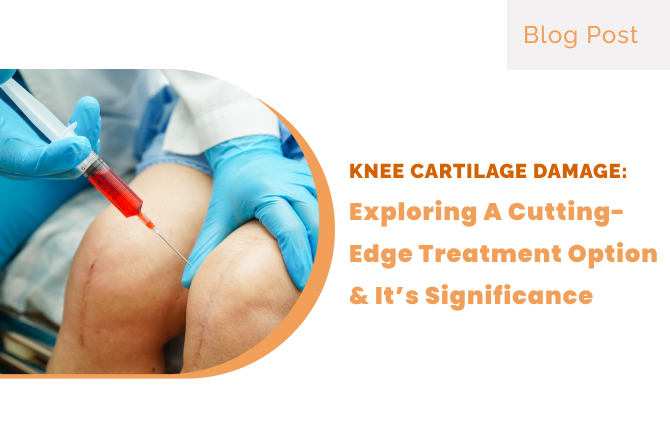PRP for Knee Cartilage Damage: Exploring a Cutting-Edge Treatment Option & It’s Significance

PRP for Knee Cartilage Damage
Overview
Knee injuries, especially those involving cartilage, can seriously affect one’s quality of life and mobility. Fortunately, advancements in medical science have led to the evolution of innovative therapies such as Platelet-Rich Plasma (PRP) treatment. In this informative blog article, let us search into the intricacies of PRP therapy for knee cartilage damage, exploring its mechanism, effectiveness, benefits, possible risks, and the future perspective of this promising treatment option.
Understanding Knee Cartilage Damage
Before getting into PRP therapy, it’s essential to understand knee cartilage damage. The knee joint includes various types of cartilage, including articular cartilage, menisci, and other structures that provide cushioning and promote smooth joint movement. However, injuries, aging, or certain medical conditions can lead to cartilage damage, resulting in pain, stiffness, and reduced mobility. Osteoarthritis, traumatic injuries, repetitive stress, and inflammatory conditions are some of the common causes of knee cartilage damage.
Platelet-Rich Plasma (PRP) Therapy: Mechanism of Action
Platelet-rich plasma (PRP) therapy is a cutting-edge regenerative treatment for knee cartilage damage that shows great promise. This innovative procedure involves extracting a small blood sample from the patient, which undergoes a thorough processing method to concentrate platelets and growth factors. The resulting platelet-rich plasma is then skillfully administered via injection into the affected area of the knee joint, aiming to stimulate tissue repair and regeneration.
The effectiveness of PRP therapy lies in its ability to harness the abundant growth factors within platelets. These potent growth factors play a vital role in fostering cell proliferation, angiogenesis (the formation of new blood vessels), and the essential process of tissue remodeling. By delivering a concentrated dose of growth factors directly to the site of injury, PRP therapy seeks to accelerate the healing process and actively facilitate the rejuvenation of the damaged cartilage.
Benefits of Platelet-Rich Plasma (PRP) Therapy
PRP therapy offers several advantages for patients with knee cartilage damage:
- Non-surgical: Unlike invasive procedures such as knee replacement surgery, PRP therapy is minimally invasive and does not require prolonged recovery time.
- Autologous: PRP is derived from the patient’s own blood, reducing the risk of allergic reactions or transmission of infections.
- Regenerative potential: By promoting tissue repair and regeneration, PRP therapy addresses the underlying cause of knee cartilage damage rather than simply masking symptoms.
- Safety profile: PRP therapy is generally safe, with minimal side effects reported in clinical studies.
Potential Risks and Considerations of Platelet-Rich Plasma (PRP) Therapy
- Variable efficacy: The effectiveness of PRP therapy may vary depending on factors such as the severity of knee cartilage damage, patient age, and overall health.
- Cost: PRP therapy may not be covered by insurance and can be expensive, particularly if multiple sessions are required.
- Infection risk: Although rare, there is a small risk of infection at the injection site.
- Temporary discomfort: Some patients may experience mild pain or swelling at the injection site, which typically resolves within a few days.
Efficacy of PRP Therapy for Knee Cartilage Damage
Numerous clinical studies have investigated the efficacy of PRP therapy for knee cartilage damage, with promising results. While individual responses may vary, many patients experience improvements in pain relief, joint function, and overall quality of life following PRP treatment.
A meta-analysis published in “the Journal of Orthopaedic Surgery and Research” examined the outcomes of several randomized controlled trials involving PRP therapy for knee osteoarthritis. The analysis concluded that PRP injections were associated with significant improvements in pain scores, physical function, and patient-reported outcomes compared to placebo or conventional treatments.
Furthermore, research published in “The American Journal of Sports Medicine” has demonstrated the potential of PRP therapy to promote cartilage regeneration and delay the progression of osteoarthritis. By harnessing the body’s natural healing mechanisms, PRP offers a promising alternative to more invasive interventions such as surgery.
Future Outlook
As research into regenerative medicine continues to advance, the future outlook for PRP therapy looks promising. Ongoing clinical trials are exploring novel techniques to enhance the efficacy of PRP, such as combining it with stem cell therapy or incorporating growth factors for targeted tissue regeneration.
Moreover, advancements in medical imaging and biomaterials are enabling more precise delivery of PRP to the damaged area of the knee joint, further optimizing treatment outcomes. With continued research and innovation, PRP therapy holds the potential to revolutionize the management of knee cartilage damage and improve the lives of millions of patients worldwide.
